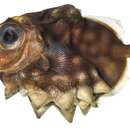Brief Summary
provided by EOL authors
Members of the deep-sea and oceanic fish family Oreosomatidae, to which the Ox-eyed Oreo (Oreosoma atlanticum) belongs, are deep bodied and laterally compressed, with large heads and eyes and a protrusible mouth. Oreos are often found at depths below 500 meters over the continental slope in most temperate (and some tropical and subtropical) waters, perhaps especially in the southern hemisphere. Many oreo species are of significant commercial value (although O. atlanticum is not due to its small size), especially in the southern hemisphere around Australia and New Zealand where deep-sea trawling is common. (Eschmeyer et al. 1983; Lowry et al. 1994). Adult Ox-eyed Oreos have a very large eye (eye diameter is ~50-60% of head length) and a prominent horizontal ridge on the operculum (gill cover) (Lowry et al. 1996). The Ox-eyed Oreo is found in the southeastern Atlantic and western Indian Oceans, occurring around South Africa between 30° and 35° S, and in the southwestern Pacific off Australia (including western and southern Australia) and New Zealand. Depth range is 220 to 1550 m. (Karrer 1986, cited in Froese and Pauly 2012; Paulin et al.1989, cited in Froese and Pauly 2012). Ox-eyed Oreos have 6-8 dorsal spines (total), 29-31 dorsal soft rays (total), 2-3 anal spines, and 28-31 anal soft rays. Pre-juveniles are blackish violet with greenish silvery cones and irregular blotches on the back (prominent cone-like outgrowths are a distinctive feature of juvenile Oreosoma, although some other juvenile oreosomatids have similar but less dramatic protuberances on their bodies). Maximum total adult length is around 21 cm. (Karrer 1986, cited in Froese and Pauly 2012)
Diagnostic Description
provided by Fishbase
Prejuveniles blackish violet in color; cones and irregular blotches on back greenish silvery (Ref. 6548).
- Recorder
- Cristina V. Garilao
Morphology
provided by Fishbase
Dorsal spines (total): 6 - 8; Dorsal soft rays (total): 29 - 31; Anal spines: 2 - 3; Analsoft rays: 28 - 31
- Recorder
- Cristina V. Garilao
Biology
provided by Fishbase
Found on the continental slope. Benthic species (Ref. 75154).
Oreosoma atlanticum: Brief Summary
provided by wikipedia EN
Oreosoma atlanticum, also known as the ox-eyed oreo, is a species of oreo found in oceanic deep waters. It is the only known member of its genus. Although adults are more similar in shape to other oreos, the juveniles have a distinctive plating/armor in their skin, which is spiked and probably makes them harder to eat for any hostile creature. Adults lack that plating, and, as other oreos, they have a protractile mouth and very large eyes, with small scales.
- license
- cc-by-sa-3.0
- copyright
- Wikipedia authors and editors
Habitat
provided by World Register of Marine Species
Known from seamounts and knolls
Stocks, K. 2009. Seamounts Online: an online information system for seamount biology. Version 2009-1. World Wide Web electronic publication.
- license
- cc-by-4.0
- copyright
- WoRMS Editorial Board

